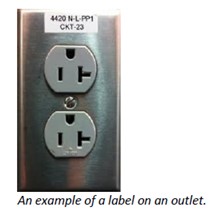The Section for Long-Term Care Regulation will be releasing a series of Life Safety Code Information. You may also view the entire Life Safety Code document for reference.
Today’s subject is:
What kind of documentation should a facility provide to the surveyor when on a fire watch?
Most facilities have one fire watch policy. If a facility has one policy, then the policy must have all the items in Chapter 15 within NFPA 25, 2011 edition. If the facility has two separate policies, the sprinkler system fire watch policy is required to include all the items in Chapter 15.
NFPA 25, 2011 edition:
Minimum Requirements
15.1.1.1 This chapter shall provide the minimum requirements for a water-based fire protection system impairment program.
15.1.1.2 Measures shall be taken during the impairment to ensure that increased risks are minimized and the duration of the impairment is limited.
Impairment Coordinator
15.2.1 The property owner or designated representative shall assign an impairment coordinator to comply with the requirements of this chapter.
15.2.2 In the absence of a specific designee, the property owner or designated representative shall be considered the impairment coordinator.
Tag Impairment System
15.3.1 A tag shall be used to indicate that a system, or part thereof, has been removed from service.
15.3.2 The tag shall be posted at each fire department connection and the system control valve, and other locations required by the authority having jurisdiction, indicating which system, or part thereof, has been removed from service.
Impaired Equipment
15.4.1 The impaired equipment shall be considered to be the water-based fire protection system, or part thereof, that is removed from service.
15.4.2 The impaired equipment shall include, but shall not be limited to, the following: Sprinkler systems, Standpipe systems, Fire hose systems, Underground fire service mains, Fire pumps, Water storage tanks, Water spray fixed systems, Foam-water systems, Fire service control valves
Preplanned Impairment Programs
15.5.1 All preplanned impairments shall be authorized by the impairment coordinator.
15.5.2 Before authorization is given, the impairment coordinator shall be responsible for verifying that the following procedures have been implemented:
(1) The extent and expected duration of the impairment have been determined.
(2) The areas or buildings involved have been inspected and the increased risks determined.
(3) Recommendations have been submitted to management or the property owner or designated representative.
(4) Where a required fire protection system is out of service for more than 10 hours in a 24-hour period, the impairment coordinator shall arrange for one of the following:
(a) Evacuation of the building or portion of the building affected by the system out of service
(b) An approved fire watch
(c) Establishment of a temporary water supply
(d) Establishment and implementation of an approved program to eliminate potential ignition sources and limit the amount of fuel available to the fire
(5) The fire department has been notified.
(6) The insurance carrier, the alarm company, property owner or designated representative, and other authorities having jurisdiction have been notified.
(7) The supervisors in the areas to be affected have been notified.
(8) A tag impairment system has been implemented. (See Section 15.3.)
(9) All necessary tools and materials have been assembled on the impairment site.
Emergency Impairments
15.6.1 Emergency impairments shall include, but are not limited to, system leakage, interruption of water supply, frozen or ruptured piping, and equipment failure.
15.6.2 When emergency impairments occur, emergency action shall be taken to minimize potential injury and damage.
15.6.3 The coordinator shall implement the steps outlined in Section 15.5.
15.7 Restoring Systems to Service
When all impaired equipment is restored to normal working order, the impairment coordinator shall verify that the following procedures have been implemented:
(1) Any necessary inspections and tests have been conducted to verify that affected systems are operational. The appropriate chapter of this standard shall be consulted for guidance on the type of inspection and test required.
(2) Supervisors have been advised that protection is restored.
(3) The fire department has been advised that protection is restored.
(4) The property owner or designated representative, insurance carrier, alarm company, and other authorities having jurisdiction have been advised that protection is restored.
(5) The impairment tag has been removed.

